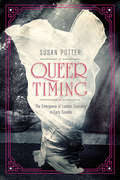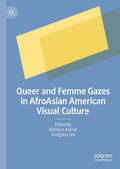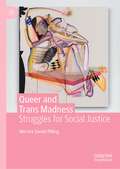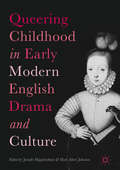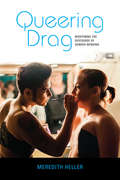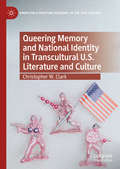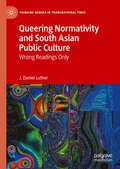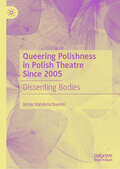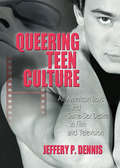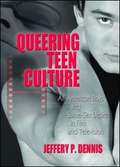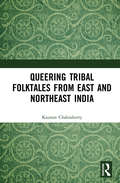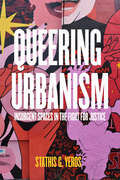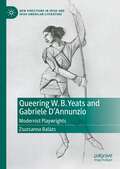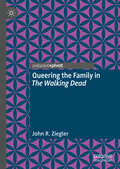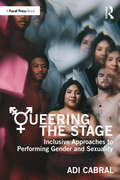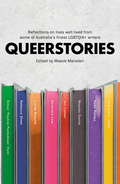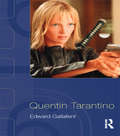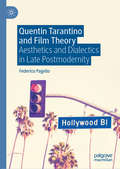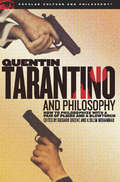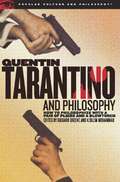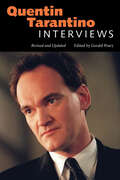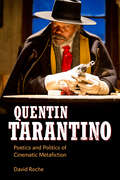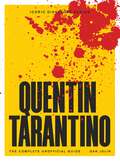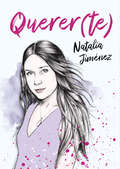- Table View
- List View
Queer Timing: The Emergence of Lesbian Sexuality in Early Cinema (Women & Film History International)
by Susan PotterIn Queer Timing, Susan Potter offers a counter-history that reorients accepted views of lesbian representation and spectatorship in early cinema. Potter sees the emergence of lesbian figures as only the most visible but belated outcome of multiple sexuality effects. Early cinema reconfigured older erotic modalities, articulated new--though incoherent--sexual categories, and generated novel forms of queer feeling and affiliation. Potter draws on queer theory, silent film historiography, feminist film analysis, and archival research to provide an original and innovative analysis. Taking a conceptually oriented approach, she articulates the processes of filmic representation and spectatorship that reshaped, marginalized, or suppressed women's same-sex desires and identities. As she pursues a sense of "timing," Potter stages scenes of the erotic and intellectual encounters shared by historical spectators, on-screen figures, and present day scholars. The result is a daring revision of feminist and queer perspectives that foregrounds the centrality of women's same-sex desire to cinematic discourses of both homo- and heterosexuality.
Queer and Femme Gazes in AfroAsian American Visual Culture
by Rebecca Kumar Seulghee LeeQueer and Femme Gazes in AfroAsian American Visual Culture is a scholarly collection that takes comparative Black-Asian representations in televisual culture from queer and femme perspectives. AfroAsian representations on screen—as well as their attendant critical gazes—have historically emphasized cross-racial masculinities at the expense of queer and/or femme visions. The prevalence of these previous televisual artefacts—and the ways they have been watched—has contributed directly to white heteronormative legacies within film and visual studies. The collection intervenes by excavating the intimacies and political possibilities within AfroAsian femme, queer, and transgender life. The authors offer alternative ways of looking at racial representation in their attendance to developments in AfroAsian visual culture: music videos, video games, genre serials, and independent and short films.
Queer and Trans Madness: Struggles for Social Justice
by Merrick Daniel PillingThis book urges those invested in social justice for 2SLGBTQ people to interrogate the biomedical model of mental illness beyond the diagnoses that specifically target gender and sexual dissidence. In this first comprehensive application of Mad Studies to queer and trans experiences of mental distress, Pilling advances a broad critique of the biomedical model of mental illness as it pertains to 2SLGBTQ people, arguing that Mad Studies is especially amenable to making sense of queer and trans madness. Based on empirical data from two qualitative research studies, this book includes analyses of inpatient chart documentation from a psychiatric hospital and interviews with those who have experienced distress. Using an intersectional lens, Pilling critically examines what constitutes mental health treatment and the impacts of medical strategies on mad queer and trans people. Ultimately, Queer and Trans Madness: Struggles for Social Justice explores the emancipatory promise of queer and trans madness, advocating for more resources to respond to crisis and distress in ways that are non-coercive, non-carceral, and honour autonomy as well as interdependence within 2SLGBTQ communities.
Queering Childhood in Early Modern English Drama and Culture
by Jennifer Higginbotham Mark Albert JohnstonThis volume analyzes early modern cultural representations of children and childhood through the literature and drama of Shakespeare and his contemporaries. Contributors include leading international scholars of the English Renaissance whose essays consider asexuals and sodomites, roaring girls and schoolboys, precocious princes and raucous tomboys, boy actors and female apprentices, while discussing a broad array of topics, from animal studies to performance theory, from queer time to queer fat, from teaching strategies to casting choices, and from metamorphic sex changes to rape and cannibalism. The collection interrogates the cultural and historical contingencies of childhood in an effort to expose, theorize, historicize, and explicate the spectacular queerness of early modern dramatic depictions of children.
Queering Drag: Redefining the Discourse of Gender-Bending
by Meredith HellerTheatrical gender-bending, also called drag, is a popular form of entertainment and a subject of scholarly study. However, most drag studies do not question the standard words and ideas used to convey this performance genre. Drawing on a rich body of archival and ethnographic research, Meredith Heller illuminates diverse examples of theatrical gender-bending: male impersonation in variety and vaudeville (1860–1920); the "sexless" gender-bending of El Teatro Campesino (1960–1980); queer butch acts performed by black nightclub singers, such as Stormé DeLarverie, instigator of the Stonewall riots (1910–1970); and the range of acts that compose contemporary drag king shows. Heller highlights how, in each case, standard drag discourses do not sufficiently capture the complexity of performers' intents and methods, nor do they provide a strong enough foundation for holistically evaluating the impact of this work. Queering Drag offers redefinition of the genre centralized in the performer's construction and presentation of a "queer" version of hegemonic identity, and it models a new set of tools for analyzing drag as a process of intents and methods enacted to effect specific goals. This new drag discourse not only allows for more complete and accurate descriptions of drag acts, but it also facilitates more ethical discussions about the bodies, identities, and products of drag performers.
Queering Memory and National Identity in Transcultural U.S. Literature and Culture (American Literature Readings in the 21st Century)
by Christopher W. ClarkThis book examines the queer implications of memory and nationhood in transcultural U.S. literature and culture. Through an analysis of art and photography responding to the U.S. domestic response to 9/11, Iraq war fiction, representations of Abu Ghraib and Guantánamo Bay, and migrant fiction in the twenty-first century, Christopher W. Clark creates a queer archive of transcultural U.S. texts as a way of destabilizing heteronormativity and thinking about productive spaces of queer world-building. Drawing on the fields of transcultural memory, queer studies, and transculturalism, this book raises important questions of queer bodies and subjecthood. Clark traces their legacies through texts by Sinan Antoon, Mohamedou Ould Slahi among others, alongside film and photography that includes artists such as Nina Berman and Hasan Elahi. In all, the book queers forms of cultural memory and national identity to uncover the traces of injury but also spaces of regeneration.
Queering Normativity and South Asian Public Culture: Wrong Readings Only (Thinking Gender in Transnational Times)
by J. Daniel LutherThis book develops a queer methodology to analyse a queer archive for the impact of normativity on subjecthood and the ways in which it shapes and curtails gender and sexuality. Chapters demonstrate how normativity functions to mask its own operation, is internalised by subjects, and is continually reproduced through discourse and in material ways. In seeking to make visible the functioning of normativity, the book performs a task of queering normativity by querying that which appears as natural in South Asian public culture. The book engages with both the consolidation and the unsettling of normativity through artefacts of South Asian public culture including canonical figures such as Rabindranath Tagore, literary and cinematic texts, Bollywood films, advertisements, social media posts, and ubiquitous ephemera in South Asia and beyond. Through these texts, the author unpacks the construct of canon, the nation, woman as a post-colonial subject, the home and the child, marriage, same-sex sexuality and identity.This book will be of interest to scholars and students studying and researching Queer Studies, Gender and Sexuality Studies, South Asian Studies, Cultural Studies, Literary Studies, Film Studies, and Media Studies.
Queering Polishness in Polish Theatre Since 2005: Dissenting Bodies
by Jonas VanderschuerenTheatre has long been an art form at the centre of public life in Poland. Whether it is the self-professed poet-prophets of the Romantic era, or the dissident theatre makers working under the strictures of state socialism, the art form has played a vital role in the development of Polish culture and politics in the context of shifting foreign occupations. This book explores the relationship between contemporary Polish theatre makers and contemporary notions of Polishness and argues that queer theory, and specifically a Polish appropriation of queer theory, can be a crucial element to better understand the politicality of the contemporary Polish theatre field. It does this by focusing on critical theatre productions which are produced at the margins of the Polish theatre field, a choice which has been made as the field is dominated by traditional drama theatres which reproduce a Polish variation on the Western canon. This makes smaller, atypical, and independent theatre productions all the more significant, as they signify a refusal to continue the traditional role of the Polish theatre field in reproducing the canon of Polish Romanticism. As such, the book argues that contemporary Polish theatre has been marked by a struggle between those building performances and state authorities that see those creations as a threat to their authority.
Queering Teen Culture: All-American Boys and Same-Sex Desire in Film and Television
by Jeffery P DennisWhy did Fonzie hang around with all those high school boys?Is the overwhelming boy-meets-girl content of popular teen movies, music, books, and TV just a cover for an undercurrent of same-sex desire? From the 1950s to the present, popular culture has involved teenage boys falling for, longing over, dreaming about, singing to, and fighting over, teenage girls. But Queering Teen Culture analyzes more than 200 movies and TV shows to uncover who Frankie Avalon&’s character was really in love with in those beach movies and why Leif Garrett became a teen idol in the 1970s. In Top 40 songs, teen magazines, movies, TV soap operas and sitcoms, teenagers are defined by their pubescent "discovery" of the opposite sex, universally and without exception. Queering Teen Culture looks beyond the litany to find out when adults became so insistent about teenage sexual desire-and why-and finds evidence of same-sex desire, romantic interactions, and identities that, according to the dominant ideology, do not and cannot exist. This provocative book examines the careers of male performers whose teenage roles made them famous (including Ricky Nelson, Pat Boone, Fabian, and James Darren) and discusses examples of lesbian desire (including I Love Lucy and Laverne and Shirley). Queering Teen Culture examines: Ozzie and Harriet, Father Knows Best, and Leave It to Beaver: Were Ricky, Bud, and Wally sufficiently straight? the juvenile delinquent films of the 1950s: Why weren&’t the rebel-without-a-cause "bad boys" interested in girls? horror, sci-fi, and zombies from outer space: "Body of a boy! Mind of a monster! Soul of an unearthly thing!" teen idols-pretty, androgynous, and feminine: No wonder they were rumored to be "funny" beach movies: She wants to plan their wedding but he wants to surf, sky-dive and go drag racing with the guys Biker-hippies boys of the late 1960s: "I know your scene-don&’t think I don&’t!" the 1950s nostalgia of the 1970s: Why does Fonzie spend all his time with high school boys? teen gore: What makes the psycho-killer angry? and much more, including Gidget, the Brat Pack, buddy dramas, nerds and "operators," Saved by the Bell, The Real World, and the incredible shrinking teenager Queering Teen Culture is an essential read for academics working in cultural and gay studies, and for anyone else with an interest in popular culture.
Queering Teen Culture: All-American Boys and Same-Sex Desire in Film and Television
by Jeffrey P. DennisExamines text and subtext in relationships between male characters in t.v. and film from the 1950s through the present.
Queering Tribal Folktales from East and Northeast India
by Kaustav ChakrabortyThis book explores queer potentialities in the tribal folktales of India. It elucidates the queer elements in the oral narratives of four indigenous communities from East and Northeast India, which are found to be significant repositories of gender fluidity and non-normative desires. Departing from the popular understanding that ‘Otherness’ results largely from undue exposure to Western permissiveness, the author reveals how minority sexualities actually have their roots in aboriginal indigenous cultures and do not necessarily constitute a mimicry of the West. The volume endeavours to demystify the politics behind such vindictive propagation to sensitize the queerphobic mainstream about the essential endogenous presence of the queer in the spaces that are aboriginal. Based on extensive interdisciplinary research, this book is a first of its kind in the study of indigenous queer narratives. It will be useful to scholars and researchers of queer studies, gender studies, tribal and indigenous studies, literature, cultural studies, postcolonialism, sociology, political studies and South Asian studies.
Queering Urbanism: Insurgent Spaces in the Fight for Justice
by Stathis G. YerosA free ebook version of this title is available through Luminos, University of California Press’s Open Access publishing program. Visit www.luminosoa.org to learn more. Conflicts about space and access to resources have shaped queer histories from at least 1965 to the present. As spaces associated with middle-class homosexuality enter mainstream urbanity in the United States, cultural assimilation increasingly erases insurgent aspects of these social movements. This gentrification itself leads to queer displacement. Combining urban history, architectural critique, and queer and trans theories, Queering Urbanism traces these phenomena through the history of a network of sites in the San Francisco Bay Area. Within that urban landscape, Stathis Yeros investigates how queer people appropriated existing spaces, how they expressed their distinct identities through aesthetic forms, and why they mobilized the language of citizenship to shape place and secure space. Here the legacies of LGBTQ+ rights activism meet contemporary debates about the right to housing and urban life.
Queering W. B. Yeats and Gabriele D’Annunzio: Modernist Playwrights (New Directions in Irish and Irish American Literature)
by Zsuzsanna BalázsQueering W. B. Yeats and Gabriele D’Annunzio: Modernist Playwrights challenges the general resistance in scholarship and queer studies to approach Yeats and D’Annunzio through a queer lens because of their controversial affiliations with fascism and elitism, their heterosexuality and their venerated canonical status. This book provides the first fully theorised queer and comparative reading of Yeats’s and D’Annunzio’s drama. It offers the novel contention that due to their increasing involvement in queer and feminist subcultures, their plays feature feelings that are associated with queer historiography and generate ideas that began to be theorised by queer studies more than half a century after the composition of the plays. Moreover, it uncovers an alert, subversive and often coded social commentary in eight key dramatic texts by each playwright and at the same time highlights the thus far neglected commonalities between the plays and the queer historical as well as cultural contexts of these two prominent modernists.
Queering the Family in The Walking Dead
by John R. ZieglerThis book traces how The Walking Dead franchise narratively, visually, and rhetorically represents transgressions against heteronormativity and the nuclear family. The introduction argues that The Walking Dead reflects cultural anxiety over threats to the family. Chapter 1 examines the destructive competition created by heteronormativity, such as the conflict between Rick and Shane. Chapter 2 focuses on the actual or attempted participation of characters such as Carol and Negan in queer relationships. Chapter 3 interprets zombies as queer antagonists to heteronormativity, while Chapter 4 explores the incorporation of zombies into the lives of characters such as the Governor and the Whisperers. The conclusion asserts that The Walking Dead presents both queer alternatives to and damaging contradictions within the traditional heterosexual family model, helping to question this model and to consider the struggle of queer American families. Overall, this study holds special interest for students and scholars of queerness, zombies, and the family.
Queering the Stage: Inclusive Approaches to Performing Gender and Sexuality
by Adi CabralQueering the Stage: Inclusive Approaches to Performing Gender and Sexuality addresses a history of stereotyping and provides inclusive approaches to navigating gender and sexuality in a way that does not reduce the broad spectrum of LGBTQ+ communities into a single monolith.Butch it up! Be more manly! Add a little swish! Queen out! These instructions make performers feel minimized, erased, and forced to fit in a binary that encourages underdeveloped portrayals of queer identities. This book will guide the reader in performance techniques for confidently embodying the masculine/ feminine, gay/ straight binaries – as concepts of chosen choreography rather than reductive prescriptions – while also providing non- binary exercises to explore and expand the use of the body, voice, heart, and mind to bring life to characters of sexual orientations and gender identities that do and do not align with the actors’ lived experiences. The reader will be presented with multiple tools for analyzing, developing, and embodying a diverse array of characters, empowering them to make their own choices when it comes to performance. While there is no “right” way to teach performance, this book will present tools rooted in trauma- informed practices that aim to prevent and undo harm in a group setting with a facilitator, or individually.This book is written for instructors of theatre performance and acting wishing to expand their curriculum to include queer concepts in their classroom, and actors working in the industry who want to improve their ability performing characters of diverse genders and sexualities.A companion website, available at www.adicabral.com/queering-the-stage, provides additional materials to support exercises given throughout the book.
Queerstories: Reflections on lives well lived from some of Australia's finest LGBTQIA+ writers
by Maeve MarsdenThere's more to being queer than coming out and getting married. This exciting and contemporary collection contains stories that are as diverse as the LGBTQIA+ community from which they're drawn. From hilarious anecdotes of an awkward adolescence, to heartwarming stories of family acceptance and self-discovery, the LGBTQIA+ community has been sharing stories for centuries, creating their own histories, disrupting and reinventing conventional ideas about narrative, family, love and community.Curated from the hugely popular Queerstories storytelling event this important collection features stories from Benjamin Law, Jen Cloher, Nayuka Gorrie, Peter Polites, Candy Royalle, Rebecca Shaw, Simon 'Pauline Pantsdown' Hunt, Steven Lindsay Ross, Amy Coopes, Paul van Reyk, Mama Alto, Liz Duck-Chong, Maxine Kauter, David Cunningham, Peter Taggart, Ben McLeay, Jax Jacki Brown, Ginger Valentine, Candy Bowers, Simon Copland, Kelly Azizi, Nic Holas, Quinn Eades, Vicki Melson, Tim Bishop and Maeve Marsden.
Quentin Tarantino
by Edward GallafentQuentin Tarantino is one of the best-known living American filmmakers in the world, and the story of his career has been the subject of a number of books and articles. But what do his films mean? In this new study, Edward Gallafent does not look at Tarantino’s story but at the films themselves. He asks to what extent Tarantino can be seen as a specifically American filmmaker, with the kinds of preoccupations and interests that have formed part of Hollywood’s traditions, and also how he explores the expressive possibilities of current cinema. The book concentrates on the main feature films of Tarantino’s career so far: Reservoir Dogs, Pulp Fiction, Jackie Brown, and the two volumes of Kill Bill. Apart from Kill Bill the films are not treated individually, but in terms of some of the subjects that connect them together, such as success and tradition, their notorious deployment of violence, and Tarantino’s approach to story-telling: his interest in presenting events out of chronological order. The book also covers adaptations of Tarantino’s work, looking at the screenplays of True Romance and Natural Born Killers as well as the films made from them, and compares Tarantino’s approach to adapting Elmore Leonard with that of another important American filmmaker, Paul Schrader. The aim of the book is to explore these topics and to take the reader back to what the American critic Robert Warshow called the ‘actual, immediate experience of seeing and responding to the movies’. It is designed to appeal both to those who were excited by the films on first seeing them in the cinema and to those taking the opportunity of reconsidering them on the screen or on DVD.
Quentin Tarantino and Film Theory: Aesthetics and Dialectics in Late Postmodernity
by Federico PagelloThis book examines a set of theoretical perspectives that critically engage with the notion of postmodernism, investigating whether this concept is still useful to approach contemporary cinema. This question is explored through a discussion of the films written and directed by Quentin Tarantino, largely regarded as the epitome of postmodern cinema and considered here as theoretical contributions in their own right. Each chapter first presents key ideas proposed by a specific theorist and then puts them in conversation with Tarantino’s films. Jacques Rancière’s theory of art is used to reject postmodernism’s claims about the ‘death’ of the aesthetic image in contemporary cinema. Fredric Jameson’s and Slavoj Žižek’s dialectical thinking is mobilized to challenge simplistic, ideological readings of postmodern cinema in general, and Tarantino’s films in particular. Finally, the direct influence of Carol Clover’s psychoanalytical approach to the horror genre on Tarantino’s work is discussed to prove the director’s specific contribution to a theoretical understanding of contemporary film aesthetics.
Quentin Tarantino and Philosophy
by Richard Greene K. Silem MohammadThe films of Quentin Tarantino are ripe for philosophical speculation, raising compelling questions about justice and ethics, violence and aggression, the nature of causality, and the flow of time. In this witty collection of articles, no subject is too taboo for the writers to tackle. From an aesthetic meditation on the use of spraying blood in Kill Bill to the conundrum of translation and reference in Vincent and Jules' discussion about French Big Macs in Pulp Fiction, Tarantino and Philosophy shies away from nothing. Is The Bride a heroic figure, even though she's motivated solely by revenge? How is Tarantino able to create a coherent story when he jumps between past, future, and present? The philosophers in this book take on those questions and more in essays as provocative as the films themselves.
Quentin Tarantino and Philosophy: How to Philosophize with a Pair of Pliers and a Blowtorch
by Richard Greene K. Silem MohammadFifteen essays presented by Greene (philosophy, Weber State U) and Mohammad (language, literature, and philosophy, Southern Oregon U) explore a range of philosophical questions through engagements with the films of director Quentin Tarantino. Topics include a Nietzschean reading of Reservoir Dogs, the ethics of revenge and mercy and the recitation of the biblical passage Ezekiel 25:17 in Pulp Fiction, the ethics of vengeance in Kill Bill, knowledge and pragmatism in Jackie Brown, transformations of time and causality in Pulp Fiction, Kill Bill as Oedipal play, and elements of Buddhist philosophy in Kill Bill.
Quentin Tarantino: Interviews, Revised and Updated (Conversations with Filmmakers Series)
by Gerald PearyHere, in his own colorful, slangy words, is the true American Dream saga of a self-proclaimed "film geek," with five intense years working in a video store, who became one of the most popular, recognizable, and imitated of all filmmakers. His dazzling, movie-informed work makes Quentin Tarantino's reputation, from his breakout film, Reservoir Dogs (1992), through Kill Bill: Vol. 1 (2003) and Kill Bill: Vol. 2 (2004), his enchanted homages to Asian action cinema, to his rousing tribute to guys-on-a-mission World War II movie, Inglourious Basterds (2009). For those who prefer a more mature, contemplative cinema, Tarantino provided the tender, very touching Jackie Brown (1997). A masterpiece--Pulp Fiction (1994). A delightful mash of unabashed exploitation and felt social consciousness--his latest opus, Django Unchained (2012).From the beginning, Tarantino (b. 1963)--affable, open, and enthusiastic about sharing his adoration of movies--has been a journalist's dream. Quentin Tarantino: Interviews, revised and updated with twelve new interviews, is a joy to read cover to cover because its subject has so much interesting and provocative to say about his own movies and about cinema in general, and also about his unusual life. He is frank and revealing about growing up in Los Angeles with a single, half-Cherokee mother, and dropping out of ninth grade to take acting classes. Lost and confused, he still managed a gutsy ambition: young Quentin decided he would be a filmmaker.Tarantino has conceded that Ordell (Samuel L. Jackson), the homicidal African American con man in Jackie Brown, is an autobiographical portrait. "If I hadn't wanted to make movies, I would have ended up as Ordell," Tarantino has explained. "I wouldn't have been a postman or worked at the phone company. . . . I would have gone to jail."
Quentin Tarantino: Poetics and Politics of Cinematic Metafiction
by David RocheQuentin Tarantino’s films beg to be considered metafiction: metacommentaries that engage with the history of cultural representations and exalt the aesthetic, ethical, and political potential of creation as re-re-creation and resignification. Covering all eight of Quentin Tarantino’s films according to certain themes, David Roche combines cultural studies and neoformalist approaches to highlight how closely the films’ poetics and politics are intertwined. Each in-depth chapter focuses on a salient feature, some which have drawn much attention (history, race, gender, violence), others less so (narrative structure, style, music, theatricality).Roche sets Tarantino’s films firmly in the legacy of Howard Hawks, Jean-Luc Godard, Sergio Leone, and the New Hollywood, revising the image of a cool pop-culture purveyor that the American director cultivated at the beginning of his career. Roche emphasizes the breadth and depth of his films’ engagement with culture, highbrow and lowbrow, screen and print, American, East Asian, and European.
Quentin Tarantino: The Complete Unofficial Guide (Iconic Directors)
by Dan JolinQuentin Tarantino is one of the most iconic and best loved movie directors of the last two decades. Whether he's shooting up the Deep South, slicing through the Japanese underworld, blasting Nazi-occupied France or taking a flamethrower to '60s Los Angeles, Tarantino is a director who combines a radical vision with a sense of history: making movies precisely the way he wants, to celebrate the movies he loves. Featuring insights into his inspirations - from martial-arts epics to Spaghetti Westerns - and dishing up fascinating details from his productions, this is an indispensable guide to Tarantino's thrilling and sometimes controversial body of work.It takes in his searing debut Reservoir Dogs, the era-defining Pulp Fiction and the genre-subverting Django Unchained, among other modern classics, right up to his nostalgic masterpiece Once Upon A Time in Hollywood. Above all, this is a celebration of a filmmaker who has arguably made a bigger impact on modern pop culture than any other.
Quentin Tarantino: The Complete Unofficial Guide (Iconic Directors)
by Dan JolinQuentin Tarantino is one of the most iconic and best loved movie directors of the last two decades. Whether he's shooting up the Deep South, slicing through the Japanese underworld, blasting Nazi-occupied France or taking a flamethrower to '60s Los Angeles, Tarantino is a director who combines a radical vision with a sense of history: making movies precisely the way he wants, to celebrate the movies he loves. Featuring insights into his inspirations - from martial-arts epics to Spaghetti Westerns - and dishing up fascinating details from his productions, this is an indispensable guide to Tarantino's thrilling and sometimes controversial body of work.It takes in his searing debut Reservoir Dogs, the era-defining Pulp Fiction and the genre-subverting Django Unchained, among other modern classics, right up to his nostalgic masterpiece Once Upon A Time in Hollywood. Above all, this is a celebration of a filmmaker who has arguably made a bigger impact on modern pop culture than any other.
Querer(te)
by Natalia JiménezEl primer libro de Natalia Jiménez. Una conmovedora historia de superación que puede inspirar a much@s niñ@s. «Quiero dejar el miedo atrás y compartir mi experiencia con la esperanza de que la lectura de este libro pueda llegar a ayudar a alguien. »Quiero que veáis que a veces lo "bueno" también puede traer consecuencias inesperadas y que muchas veces luchas contra ti mismo cuando tienes un problema, en vez de admitir que lo hay. »Voy a contar una historia que NADIE sabía hasta este momento. Algo que no podrías imaginar que te puede pasar cuando acabas de cumplir uno de tus sueños. »Pero también quiero compartir todo lo que he aprendido, y todo lo que he pasado hasta llegar a ser como soy, y a aceptarme y quererme de este modo.»Natalia Jiménez
